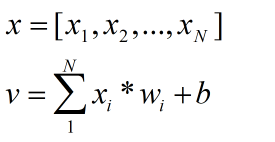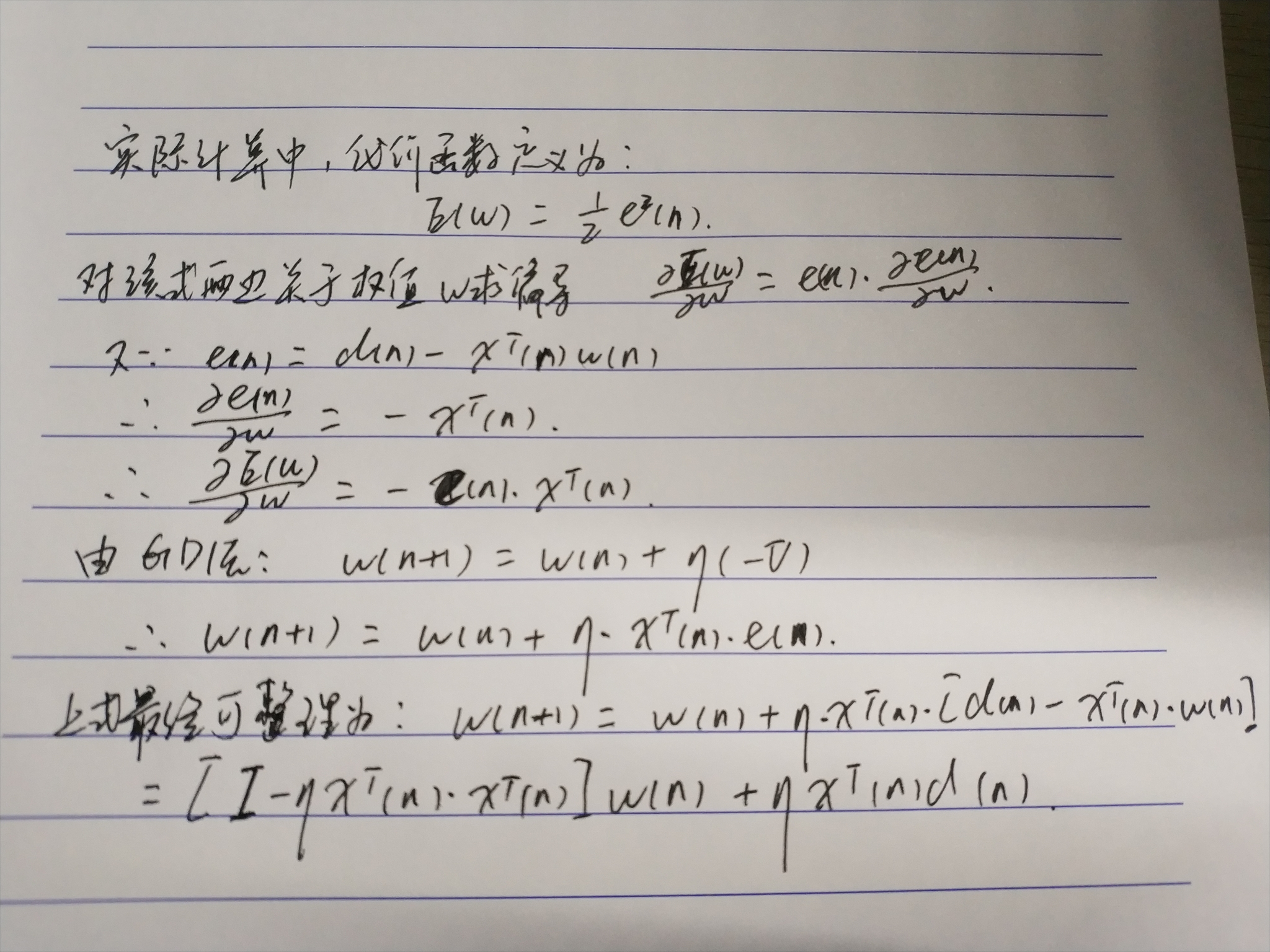自适应线性元件20世纪50年代末由Widrow和Hoff提出,主要用于线性逼近一个函数式而进行模式联想以及信号滤波、预测、模型识别和控制等。
线性神经网络和感知器的区别是,感知器只能输出两种可能的值,而线性神经网络的输出可以取任意值。线性神经网络采用Widrow-Hoff学习规则,即LMS(Least Mean Square)算法来调整网络的权值和偏置。线性神经网络在结构上与感知器非常相似,只是神经元激活函数不同。在模型训练时把原来的sign函数改成了pureline函数(y=x)
只能解决线性可分的问题。
与感知器类似,神经元传输函数不同。
线性神经网络结构

两个激活函数,当训练时用线性purelin函数,训练完成后,输出时用到sign函数 (>0, <0)
假设输入是一个N维向量(公式1),从输入到神经元的权值为wi,则输出为公式2.

若传递函数采用线性函数purelin,则输入与输出为一个简单的比例关系,x(n),w(n),y,q写成矩阵的形式,公式如下、

若网络中包含多个神经元节点,则可以形成多个输出,这种可以以两种间接的方式解决线性不可分问题
- 用多个线性函数对区域进行划分,然后对各个神经元的输出做逻辑运算
- 或者对神经元添加非线性输入,引入非线性成分。
LMS 最小均方规则
LMS 学习规则可以看作是δ学习规则的一个特殊情况
LMS算法只能训练单层网络,,但是单层网络理论上讲不会比单层网络差。
该学习规则与神经元采用的转移函数无关,因而不需要对转移函数求导,不仅学习速度较快,而且具有较高的精度,权值可以初始化为任意值,通过权值调整使得神经元实际输出与期望输出之间的平方差最小:
定义某次迭代时的信号为 e(n)=d(n)-xT(n)w(n)
n为迭代次数,d表示期望输出,采用均方误差作为评价指标。

Q是输入训练样本的个数。线性神经网络学习的目标是找到适当的w,使得均方差mse最小。mse对w求偏导,令偏导等于0求得mse极值,因为mse 必为正,二次函数凹向上,求得的极值必为极小值。
实际运算中,为了解决权值w维数过高,给计算带来困难,往往调节权值,使mse从空间中的某一点开始,沿着斜面向下滑行,最终达到最小值。滑行的方向使该店最陡下降的方向,即负梯度方向。
实际计算中,代价函数常定义为



Delta学习规则
1986年,认知心理学家McClelland和Rumelhart 在神经网络训练中引入该规则,也成为连续感知器学习规则
该学习规则是一种利用梯度下降法的一般性的学习规则
代价函数(损失函数) (Cost Function, Lost Function)
误差E是权向量Wj的函数,欲使误差E最小,Wj应与误差的负梯度成正比

梯度即是导数,对误差(代价/损失)函数求导,



梯度下降法的问题
- 学习率难以选取,太大会产生振荡,太小收敛缓慢
- 容易陷入局部最优解
- 第一个问题解决方法,开始的学习率可以设的较大,后面逐渐调小学习率
LMS算法步骤
(1)定义变量和参数。
x(n)=N+1维输入向量=[+1,x1(n),x2(n),...,xN(n)]T
w(n)=N+1维权值向量=[b(n),w1(n),w2(n),...,wN(n)]T
b(n)=偏置
y(n)=实际输出
d(n)=期望输出
η(n)=学习率参数,是一个比1小的正常数
(2)初始化。n=0,将权值向量w设置为随机值或全零值,n=0。
(3)输入样本,计算实际输出和误差,根据给定的期望输出d(n),计算得:e(n)=d(n)-xT(n)*w(n)
(4)更加所算的的结果调整权值向量(由上图所给公式)
(5)判断算法是否收敛,若满足收敛条件,则算法结束,否则继续
收敛条件:当权值向量w已经能正确实现分类时,算法就收敛了,此时网络误差为零。收敛条件通常可以是:
误差小于某个预先设定的较小的值ε。即
|e(n)|<ε
两次迭代之间的权值变化已经很小,即
|w(n+1)-w(n)|<ε
设定最大迭代次数M,当迭代了M次就停止迭代。
LMS算法中学习率的选择
LMS算法中,学习率的选择十分重要,直接影响了神经网络的性能和收敛性。
1996年Hayjin证明,只要学习率η满足  LMS算法就是按方差收敛的。
LMS算法就是按方差收敛的。
其中,λmax是输入向量x(n)组成的自相关矩阵R的最大特征值。往往使用R的迹(trace)来代替。矩阵的迹是矩阵主对角线元素之和。
可改写成 0<η<2/向量均方值之和。
学习率逐渐下降:
学习初期,用比较大的学习率保证收敛速度,随着迭代次数增加,减小学习率保证精度,确保收敛。
学习率逐渐下降如何设计:多种方式,自己可以思考思考
线性神经网络与感知器的对比
LMS算法运用梯度下降法用于训练线性神经网络,这个思想后来发展成为反向传播算法用于训练多层神经网络。
两者的传输函数不一样导致感知器只能用于分类,而线性神经网络还可以用于拟合或者逼近
LMS算法的分类边界往往处于两种模式的中间,容错能力强,感知器算法则在刚好能正确分类的地方就停下了,容错能力差。
Python实现LMS算法
#! /usr/bin/env python # -*- coding:utf-8 -*- import numpy as np import pandas as pd def sgn(x): # the sgn function if x >= 0: return 1 else: return -1 class LinearNeuralNetwork(object): """ This is the Perception of the Neural Newtork. I implement the algorithm by myself. """ def __init__(self, input_data, input_label, learning_rate=0.05, iter_times=5000): """ :param input_data: is the np.array type and size is [m, n] which m is number of data, n is the length of a input :param input_label: is the np.array type and size is [1, m] which m is number of data :param learning_rate: :param iter_times: """ self.datas = np.ones((input_data.shape[0], input_data.shape[1] + 1)) self.datas[:, 1:] = input_data self.label = input_label self.weights = (np.random.random(size=self.datas.shape[1]) - 0.5) * 2 # make the weights in [-1, 1] self.learning_rate = learning_rate self.iter_times = iter_times for i in range(self.iter_times): for j in range(self.datas.shape[0]): e = self.label[j] - np.dot(self.datas[j], self.weights.T) new_w = self.weights + self.learning_rate * e * self.datas[j] self.weights = new_w if sum(abs(self.label - np.dot(self.datas, self.weights))) <= 0.001: # if |y(n) - d(n)| <=0.001, break print("The perception is work well!") break print("The real data output:", self.label) print("LMS of y output is :", np.array([x for x in np.dot(self.datas, self.weights.T)])) print("LMS of q output is :", np.array([sgn(x) for x in np.dot(self.datas, self.weights.T)]))
运用实现的LMS算法处理一些数据
#! /usr/bin/env python # -*- coding:utf-8 -*- import numpy as np import pandas as pd def sgn(x): # the sgn function if x >= 0: return 1 else: return -1 class LinearNeuralNetwork(object): """ This is the Perception of the Neural Newtork. I implement the algorithm by myself. """ def __init__(self, input_data, input_label, learning_rate=0.05, iter_times=5000): """ :param input_data: is the np.array type and size is [m, n] which m is number of data, n is the length of a input :param input_label: is the np.array type and size is [1, m] which m is number of data :param learning_rate: :param iter_times: """ self.datas = np.ones((input_data.shape[0], input_data.shape[1] + 1)) self.datas[:, 1:] = input_data self.label = input_label self.weights = (np.random.random(size=self.datas.shape[1]) - 0.5) * 2 # make the weights in [-1, 1] self.learning_rate = learning_rate self.iter_times = iter_times for i in range(self.iter_times): for j in range(self.datas.shape[0]): e = self.label[j] - np.dot(self.datas[j], self.weights.T) new_w = self.weights + self.learning_rate * e * self.datas[j] self.weights = new_w if sum(abs(self.label - np.dot(self.datas, self.weights))) <= 0.001: # if |y(n) - d(n)| <=0.001, break print("The perception is work well!") break print("The real data output:", self.label) print("LMS of y output is :", np.array([x for x in np.dot(self.datas, self.weights.T)])) print("LMS of q output is :", np.array([sgn(x) for x in np.dot(self.datas, self.weights.T)])) def main(): X = np.array([[1, 3, 3], [1, 4, 3], [1, 1, 1]]) Y = np.array([1, 1, -1]) LinearNeuralNetwork(X, Y) if __name__ == '__main__': main()